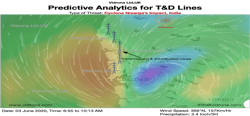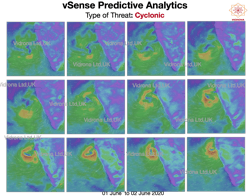Enabling Storm Resilience during COVID-19
Vidrona Ltd., a predictive physical asset management company in the United Kingdom, recently released a case study on how hurricane resilience of T&D utilities in the United States, New Zealand, and India can improve using the company’s artificial intelligence (AI)-based platform, vNautilus.
The weather feature of vNautilus, a predictive analytics platform, allows T&D utilities to refine storm resilience strategies. The platform categorizes assets on the basis of their probability of being damaged in an approaching storm.
The case study considered three scenarios: pre-hurricane, during hurricane and post-hurricane.
Pre-hurricane: Helping utilities prepare
The platform used impact analytics to predict and monitor the potential damage of T&D assets by a hurricane. The exercise started at least 15 days before the storm struck. Two features of predictive analytics — asset-condition health monitoring and predictive vegetative-arboriculture analytics — were combined and auto-correlated to generate health scores for individual assets. Based on the health score, each asset was classified under one of the categories — critical, major, minor, and healthy.
The analytics based on satellite weather data helped generate a profile of the storm envelope for a zone, identifying only the assets that would bear the brunt of the hurricane and had to be isolated from the smart grid. An emergency maintenance regime was initiated for assets that were critical or major. The maintenance had to be completed before the landfall of the hurricane.
The platform identified safe locations for a Quick Response Team (QRT) and provisioned an inventory of equipment and components that would be needed for assets that would be damaged in the hurricane and also in case emergency maintenance could not be completed in time.
As a precaution because of the ongoing pandemic, personal protective equipment (PPE) such as masks, gloves, glasses, safety boots, and head gears were also provisioned for the QRT sites.
The following measures were meant to avoid mishaps:
- Locking gantry cranes at casting yards
- Removal of loose materials from concourse/platform levels at metro or railway station sites
- Lowering piling rigs and keeping them in a horizontal position
- Protecting electrical boards
During hurricane: Actions taken
The final list of assets that required action was decided after taking into account the aggregated analytics and the last six-hour course of the hurricane. The 10% of assets immediately outside the list of assets under threat from the storm were added to it. Only the overhead power lines on the list had to be disengaged for the duration of the storm. The precautionary measures were in place for 30 minutes in addition to the duration of the hurricane.
Post-hurricane: How did it benefit utilities
The disengaged power lines were brought back into the grid after the hurricane. Small sections of the pre-identified assets that were damaged and, therefore, could not be introduced into the grid were immediately attended to as potential breakdown because of electrical component failure or impact of fallen trees on assets or power lines had already been highlighted over vNautilus.
Not only did the platform allow utilities to be better prepared to face the storm but also to quickly get lines back up and running, thereby avoiding critical power cuts in healthcare institutions battling COVID-19.




